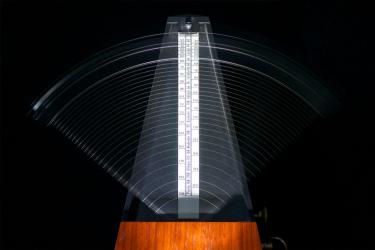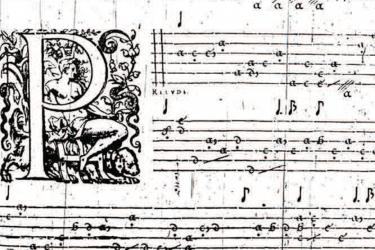

In this essay, I will explore the origin of tempo, modern note values and time signatures such as the symbols "C" for 4/4 time, also known as common time; and a vertical line or stroke on the symbol "C" for 2/2 time, also known as alla breve, by examining the predecessor of modern notation system called mensural notaion.
Mensural notation originates in the later part of the 13th century and developed throughout until around 1600 when it evolved into modern notation system.
There is a theory that the very early example of those time signatures (C and slashed C) are found in a collection of musical essays known as "Ars Nova" (c. 1322) attributed to Philippe de Vitry (31 October 1291 – 9 June 1361), a renowned poet, music theorist, composer, diplomat and bishop. On the other hand, a musicologist Sarah Fuller made a provocative suggestion in 1985 that Vitry’s Ars nova was "a phantom treatise", questioning his authorship and the very existence of the treatise(see ref. at the bottom of this essay).
This article will look into the musical treatise Plaine and Easie Introduction to Practicall Musicke (1597) written by Thomas Morley which gives us insight into mensuration system used between the 15th and 16th century.
Note values in modern notation

A note value indicates the relative duration of a note. The chart above is a typical modern unmodified note-value tree showing relative relationships among different subdivisions, which is always a power of two (binary). The chart shows only up to quavers (eighth notes), but subdivisions go on in the same way. This binary system has been in use from 1600.
Note values in Renaissance mensural notation

Before 1600, more precisely, from the latter half of the 15th century to the 16th century, white mensural notation was used. In this system, note values were the powers of either two (binary) or three (ternary) depending on the "mensuration" signs located at the beginning of a composition. And, as you can clearly see, this is the ancestor of the modern time signatures for 2/2 time (alla breve) and 4/4 time (common time).
Mensuration signs
It is important to mention that mensural notation was developed by catholic religious orders and we can see some religious symbolism in it.
On the table 1 above, the mensuration sign "O (full circle)" symbolizes the Trinity, a perfect whole made of three elements (triple meter). The mensuration "C" represents an imperfect whole because it is made of only two elements (duple meter).

The table 2 is a close-up of the first two columns of the table 1 above showing the relative relationships among subdivisions for the mensuration sign "O3".
The numbers in yellow represent the ratio of semibrevis (today's semibreve/whole note) to the note in question. For example, the value of the "brevis" is equal to the value of "3" semibreves. In the same way, the value of the "maxima" is equal to the value of "27" semibreves.
The numbers in cyan represent relative relationships between the neighbouring subdivisions, either a fraction power of two (binary) or three (ternary). For example, the "2" in the second row means that the "semibrevis" is divisible by two, resulting two minimae. In the same way, the "longa" is divisible by "3", resulting three breves.
The mensuration sign "O" and "C" were also used in combination with numbers, a dot in the center of a sign, resulting a variety of mensurations.


For example, the mensuration sign "O2" signifies that the relative relationship among subdivisions is a power of two (binary) except between "longa" and "breve" which is a power of three (ternary) according to the table 1 (see the third mensuration sign from the left highlighted in orange).


The mensuration sign "O" indicates that the relative relationship among subdivisions is a power of two (binary) except between "brave" and "semibrevis" which is a power of three (ternary).
Perfectum and imperfectum
The relationships of relative note values from maxima to semibrevis are powers of either two or three. When the power of three is applied, it is called perfectum (perfect), while the power of two is applied, it is called imperfectum (imperfect). Smaller note values are always imperfectum (divisible by two).
Mensurations: Maximodus, modus, tempus, and prolatio
The division of a maxima into longae, a longa into breves, a brevis into semibreves, and a semibrevis into minimae are called successively maximodus, modus (Modes), tempus (time), and prolatio (Prolation) [see the table 1].
When prolatio is ternary (divisible by three), it is called maior and when it is binary (divisible by two), it is called minor.
Diminished variants of the mensuration signs (diminution)
 |
 |
 |
 |
|
| Diminutum |
 |
 |
 |
 |
Each of the mensuration signs can have a diminished variant, indicated by a vertical stroke through the sign. This is called diminutum or diminution. These slashed signs represent a reduction of all temporal values by two (twice as fast).
The origin of the common time and alla breve signs

As the table above shows, when the mensuration sign is "C", the relationship among all the subdivisions is a power of two (binary) .

The chart 2 is a note-value tree for mensural sign "C", which reminds me of something very familiar. Yes, that's right, this is the origin of the binary modern note value system and the modern practice of using the sign "C" as time signature for "4/4" time. The sign "C" became known as today's "common time" thus.

Likewise, slashed mensuration sign "C", diminutum or diminution, is the ancestor of today's alla breve also known as "cut time" or "cut common time" for 2/2 time.
Plaine and Easie Introduction to Practicall Musicke (1597)
The images below are excerpt from Plaine and Easie Introduction to Practicall Musicke (1597) by Thomas Morley. Morley was an English composer, theorist, editor and organist of the Renaissance, and the foremost member of the English Madrigal School.







